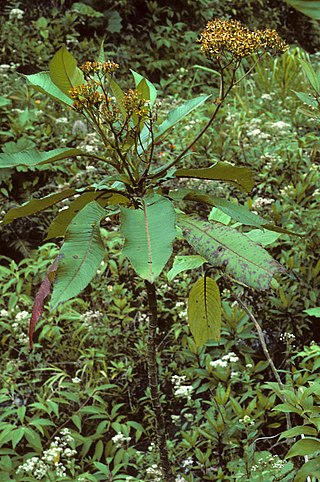
Senecio is a genus of flowering plants in the daisy family (Asteraceae) that includes ragworts and groundsels.

Senecioneae is the largest tribe of the Asteraceae, or the sunflower family, comprising over 150 genera and over 3,500 species. Almost one-third of the species in this tribe are placed in the genus Senecio. Its members exhibit probably the widest possible range of form to be found in the entire plant kingdom, and include annuals, minute creeping alpines, herbaceous and evergreen perennials, shrubs, climbers, succulents, trees, and semi-aquatic plants.

Erik Leonard Ekman was a Swedish botanist and explorer.

Aequatorium is a genus of flowering plants in the aster family. It was described as a genus in 1978. It is a member of the tribe Senecioneae and native to South America.

Calenduleae is a flowering plant tribe of the family Asteraceae. Calenduleae has been widely recognized since Alexandre de Cassini in the early 19th century. There are eight genera and over 110 species, mostly found in South Africa.
Nordenstamia is a genus of flowering plants in the family Asteraceae.
Antillanthus is a genus of the tribe Senecioneae in the family Asteraceae described as a genus in 2006. Many members of this genus were previously listed as Pentacalia and Senecio.

Oresbia heterocarpa is the perennial plant that is the only species in the South African native genus Oresbia and member of the tribe Senecioneae in the family Asteraceae.

Elekmania is a genus of the tribe Senecioneae and the family Asteraceae. Most if not all of its members used to be placed in Senecio.

Jessea is a genus of Central American plants in the tribe Senecioneae within the sunflower family, closely related to Senecio.

Pieter B. Pelser is a lecturer in Plant Systematics and the curator of the herbarium at the University of Canterbury in Christchurch, New Zealand. One research interest is the evolutionary history of the tribe Senecioneae, one of the largest tribes in the largest family of flowering plants. He wrote the most recent attempt to define and delimit this tribe and its problematic founding species Senecio. He also studies insects that eat these plants (Longitarsus) which contain pyrrolizidine alkaloids and what makes them choose which plants they eat.

Caucasalia is a genus of flowering plants in the daisy family.

Dolichoglottis is a genus of flowering plants in the daisy family, Asteraceae.

Lasiocephalus is a genus of South American flowering plants in groundsel tribe within the sunflower family. The genus was shown to be part of Senecio and predominantly occurs in tropical alpine-like regions.

Nemosenecio is a genus of East Asian flowering plants in the groundsel tribe within the sunflower family.

Phaneroglossa is a genus of plants that is assigned to the daisy family. It consists of only one species, Phaneroglossa bolusii, a perennial plant of up to 40 cm high, that has leathery, line- to lance-shaped, seated leaves with mostly few shallow teeth and flower heads set individually on top of long stalks. The flower head has an involucre of just one whorl of bracts, few elliptic, white or cream ray florets, and many yellow disc florets. It is an endemic species of the Western Cape province of South Africa. Flowering mainly occurs from November to January.
Sinosenecio, also butterweed, is a genus of Asian plants in the groundsel tribe within the daisy family. Most of the species are found only in China, with a few extending southward into Indochina.
Stenops is a genus of African flowering plants in the daisy family.

Caputia is a small genus of flowering plants in the family Asteraceae, native to South Africa. It may be of hybrid origin. Species in this genus were formerly considered part of the genus Senecio.
Oldfeltia is a genus of flowering plants belonging to the family Asteraceae. It contains only one known species, Oldfeltia polyphlebia.















